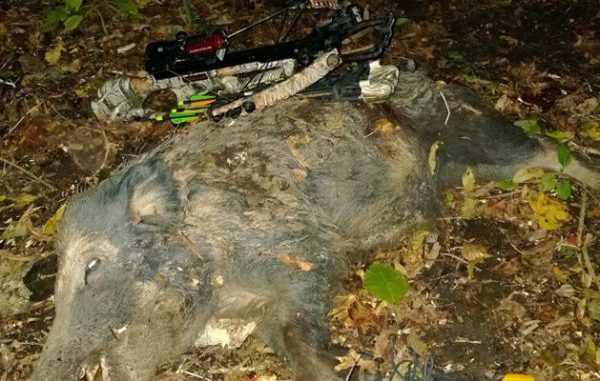
The Apex Predator leaves the woods with meat ready to cook
When a hog hunt is successful, that’s when the going sometimes gets pretty tough.
Retrieving a large animal can challenge any hunter, but since I hunt alone and rarely stay near my truck, getting hogs out of the woods can become even more of an issue.
But my backpacking method literally makes harvesting the meat a walk in the park.
The first hog I ever killed was a 250-pound boar 1.6 miles deep in Three Rivers WMA. At the time, I was so focused on shooting a pig that I never thought about how to get it out. But after tugging on that porker for what seemed like an eternity and still being within sight of my tree climber, I realized a change in tactics was necessary.
I ended up backpacking that pig out, and I haven’t looked back since.
But over the years I have fine-tuned my method. Backpacking has become so easy now that I venture further into the woods and shoot the largest pigs. And since fewer hunters venture to these remote areas, the hogs are more numerous and less pressured.
My last two hog kills were accomplished over two miles from my vehicle in Bayou Cocodrie NWR, and earlier this year I backpacked four hogs at once. Click here to read that story.
Most WMA’s now let hunters use ATVs to retrieve a downed deer or hog in the woods, but I opt to haul out my animals by foot. And on the national wildlife refuges I hunt, ATVs can’t can’t go off designated trails to get an animal.
Manual hauling is the only option, but there are various ways it can be done.
One key factor to remember is time is of the essence. A hunter must be off most public lands within two hours after shooting ends. Without a smart game plan for meat retrieval, your time will run out.
On a hot night, letting a dead hog sit risks spoiling the meat, while waiting for the next morning on a cold night will waste a potentially successful morning hunt. Even when killing on morning hunts, the quicker you finish the cleaning process, the more time you have left for an evening hunt.
The job can be done in one haul if the pig is drug out, but even hauling a gutted pig along with your gear can take hours, besides leaving you with a broken back.
Getting a cart is one strategy, but this requires a walk out of the woods with your gear, then a slow walk back to the animal and out again with the loaded cart. These three trips will take plenty of valuable time, and the hog still needs to be cleaned back at the camp. Then you have to discard the carcass – mess, mess and more mess.
Some people take their carts in before the hunt, but if you’re making over 100 hunts each season like me, this becomes impractical after a few hunts with no kills.
The quickest and easiest solution is backpacking cleaned meat out in one trip. Deer are not allowed to be cleaned in the woods, but you can with hogs. I cut off one hoof to have proof that the meat is from a hog as recommended by the wardens.
Before hunting in distant locations, I usually keep a heavy-duty scent free garbage bag, sharpened knife and pair of latex gloves in my hunting backpack. I use backpacks with straps that go around the front of the waist and chest to help support heavy loads.
If I make a quick hunt without bringing my backpack, I can still make this method quicker than using my cart. I leave my gear in the woods with my downed hog and jog out. Then, I jog back in with the backpack and cleaning gear from my vehicle. It’s the same distance traveled as using a cart, but running or briskly walking without the cart is much quicker and easier.
A large hog can be thoroughly cleaned in less than 15 minutes using my method demonstrated in the accompanying video.
I start by making a slit behind the ear from the top of the neck down to the front of the elbow, much like the first slice behind the gills when cleaning a fish. Then just like cleaning a large bull red, I make a slit in the hog’s hide from the upper neck along the center of the backbone and around the back of the lower leg stopping near the hoof.
Next, I proceed to cape the hide on this exposed side starting at the top corner of the neck , working down to the shoulder, and then to the back legs. Finally, I peel the hide to the ground still attached to the feet. Then, it’s as simple as cutting the meat from the bones. No dealing with nasty guts with my cleaning process.
Afterwards, I simply flip the animal over and repeat the process. Taking the meat off chunk-by-chunk into my bag leaves it clean and free of mud and hair. Then I quickly ice down the pork once I’m back at the camp.
Deboning the hog in the woods saves lots of time, you don’t need a bone saw or to debone the meat when processing. The meat is nearly ready to freeze or cook before you ever leave the woods.
So before your next hunt, toss a garbage bag, skinning knife and gloves in your hunting bag and give backpacking a try. Those pork chops will be in the pot and ready for supper before your uncleaned pig even makes it home.


